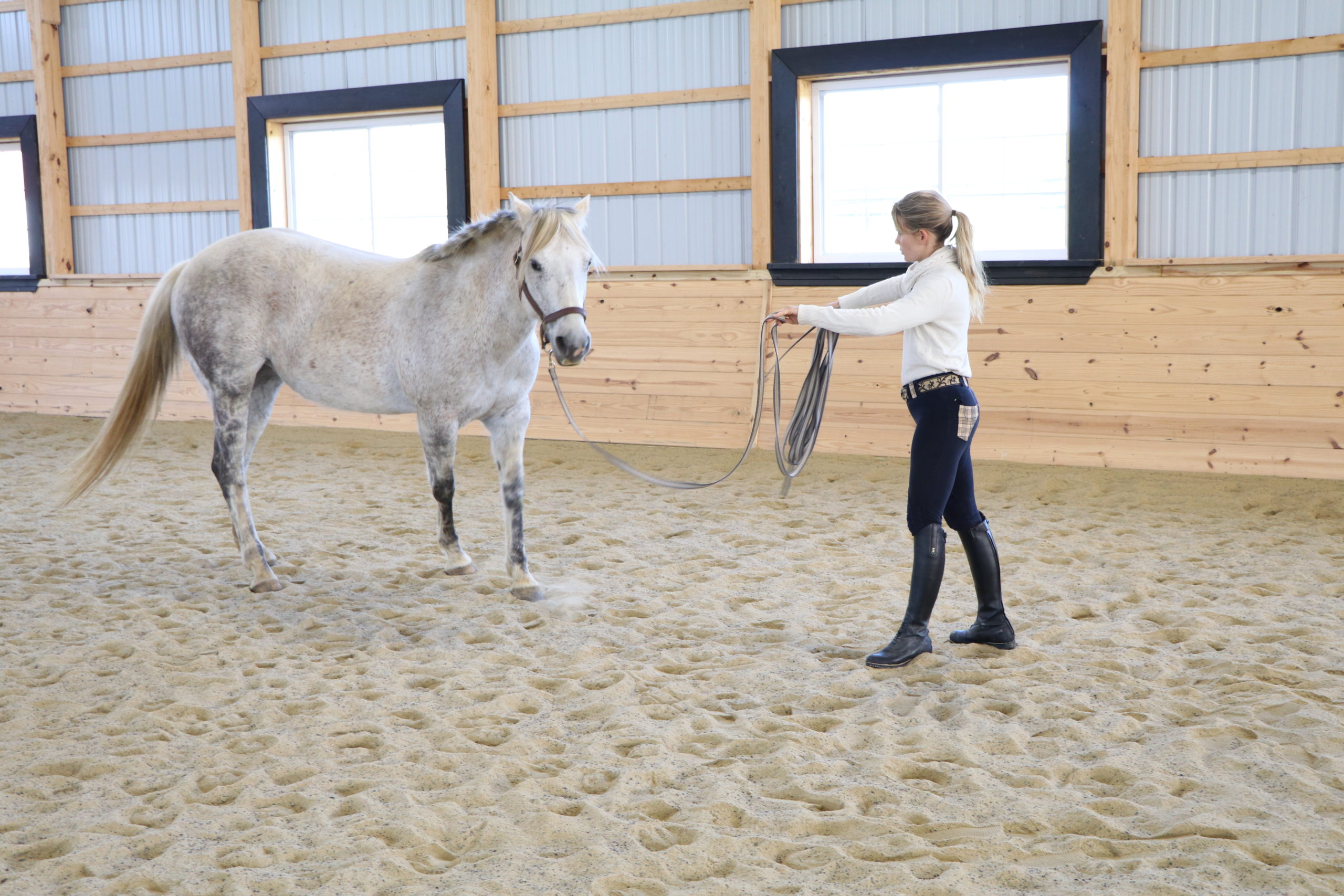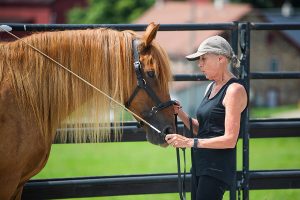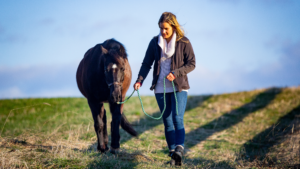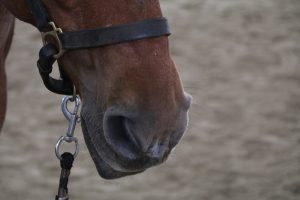Lunging is an exercise done with various intent.
Sometimes the goal is to tire the horse out a bit… to “get the bucks out”.
Other times it may be to evaluate soundness and access a horse’s movement.
Some riders lunge their horse simply because it’s part of a routine.
Lunging can be mindless, disconnecting, and create stress on the horse’s body or…
The exercise of lunging can be calming, developing strength and suppleness, and even creating an opportunity for rapport between horse and handler.
If you have ever experienced challenges during lunging, perhaps your horse leaning in, rushing around, running off, or trying to turn in and face you, I have a simple exercise and tutorial I would like to share with you.
Watch as I lunge one of my school horses, Ellie, working specifically on changing directions – a key skill for the handler during lunging, and one of the best movements for solving many problems.
Click below to watch the video and then leave a comment below – what is one lunging tip that you find most helpful?
See you in the comments!
Callie














53 Responses
In the lunging video when walking backwards and getting horse to bend sort of around you, how do you help a horse do that if they don’t bend their body?
Beverly, do you find that the bending issue is also on the ground and in the saddle? Could it be a more generalized bending or stiffness issue?
-Julia, HorseClass Community Manager
I really like your videos. I also like Elly. Such a patient expressive horse. She looked so put upon at times, ‘do I really have to Cally, gosh, can’t we just stand and chat?’ Thank you. How nice you have people like Pat King and Wendy Murdock to work with. There is a world of great education here.
Ellie is an all-star lesson horse and video star
-Julia, HorseClass Community Manager
So glad you selected this topic. I witness so many folks thinking they are lunging their horse just by having the horse walk around in a circle, trotting & then chasing them to get them up to a canter without real consideration for the impact on their horse’s mindset or physical movement and carriage. So, agree, it is really important for equestrians to take lessons from a professional coach/trainer on how to correctly lunge with the first step being identifying correct equipment and tools then really LEARNING how to lunge, proper equipment use and really what the benefit and purposes of lunging. I asked my trainer for lunge lessons and found it so effective. Groundwork is just as important as time in the saddle. Thanks for another great video!
Absolutely! We are all about holistic learning when it comes to horses – you have to learn a about every piece of horsemanship to be a well rounded equestrian. And that definitely includes learning to lunge. Ground work is important not only for riding but for relationship building too
-Julia, HorseClass Community Manager
Thank you, my take away is the way that you do the change of rein by moving backwards and switching your stick and lead so that the movement remains fluid. I will certainly be practicing that.
Definitely practice that a little Davina, it takes a little bit to get the coordination sometimes!
-Julia, HorseClass Community Manager
Thanks Callie, this was a very useful demonstration. Is that a Manolo bamboo?
I have a 60 ft round pen but no arena. Given the space needed to walk backward while changing directions, it might be a more comfortable maneuver outside the round pen in the pasture.
Thanks again!
Hi Paul, this is Honey Brook bamboo It grows naturally on the road that the farm is on so we typically just grab some of that!
It grows naturally on the road that the farm is on so we typically just grab some of that!
A round pen is a great place to practice this as well.
-Julia, HorseClass Community Manager
I am working a pony for driving. I will try the change of direction on him today. Really appreciate the tip!
This would be a great exercise for your pony Dorothy!
-Julia, HorseClass Community Manager
Like the way you take steps back when asking Elie to change direction
Glad you liked this video and the demonstration Marcia!
-Julia, HorseClass Community Manager
I have struggled when trying to turn my gelding. I really love the fluidity of your turns … Now I’m anxious to try this technique.
Give it a try and let us know how it goes Sandra!
-Julia, HorseClass Community Manager
Very helpful… I will be working more in hand.
Some trainers teach that when switching directions you should be moving toward the horse not backing up. The horse needs to step laterally away from the handler to initiate the turn. Does it matter which approach I take?
Hi! The example in the video is typically the method we recommend!
-Julia, HorseClass Community Manager
I love how you demonstrate calm, clear signals in working with your Ellie. I have been amazed to see how much benefit groundwork can have for our horses, which translates so well into our ridden work!
Groundwork is a great way to develop skills that transfer directly to the saddle.
-Julia, HorseClass Community Manager
I have never seen the snap in front of the nose. What a rear idea. What keeps the snap from sliding to the side of the face?
Hi Tammy, this is a cavesson and the rings are sewn on the noseband at specific points so they don’t move! It is a great tool for riders.
-Julia, HorseClass Community Manager
Can you share what specific cavesson you are using? Thank you for this great lunging lesson!
Hi Laura, you can click here to order the cavesson the Callie is using in this video.
-Julia, HorseClass Community Manager
Thanks for that. I enjoyed your video. I love doing ground work with my horse. He is unbalanced on one rein .i wasn’t sure how to correct it. After watching your video i will try that tomorrow.
Thank you.
Definitely give it a try Julie
-Julia, HorseClass Community Manager
Thank you so much!!! I’m excited to use the 3 cues (shoulder to move out, rear to speed up and front to slow down). Also like starting with a walk and getting that down before asking for a trot, etc.
That is a great point Christal!
-Julia, HorseClass Community Manager
This was so helpful. I am looking to improve my ground work, especially with lungeing and have a mare whose prior education I’m not sure about. I wasn’t sure how to ‘start from scratch’ with lungeing and was having trouble ‘sending’ her. This was a really clear explanation of how I can teach her to change directions. Thanks!
Hope it helps Edwina!
-Julia, HorseClass Community Manager
Hi Callie
Thank you for sharing yet another really helpful video…. My Saturday morning house chores were then further delayed because a fantastic interview about training mustangs popped up and just had to be watched
Anyway, I’m so glad it did because it really helped me to better frame the questions I have about lunging my horse Belle
Belle is “home produced” so any negative behaviours can be traced back to me! I really can’t understand her aversion to lunging but I am now inspired to ( once again) go back and try to unpick the problem. In some ways I think that’s why I enjoy helping to redirect problem horses for other people because I find it much easier to spot where someone else has gone wrong, unpick it, and in the process get the response I’m looking for, maybe I was more blase/ less thoughtful when I trained Belle, not anticipating the negative behaviours because she hadn’t had the negative experiences to lead her to them…. But Belle is very much her own horse
The reason I am glad I watched the mustang video straight after was that it clarified my confusion somewhat because I am not now starting from scratch with Belle because Belle has learned some effective diversion techniques unfortunately!
So I guess what I need some help with is how to apply the premack (?) principle to some of our problems which are as follows :
First of all I have only ever used a lunging whip to direct her… She’s not at all afraid of it because it is used in the same way as you use the bamboo rod but certainly I’m going to try switching since I’ve sometimes come unstuck with it when either Belle or I have stood on the cord!
I haven’t worked out why Belle doesn’t seem to like working in the cavesson… Have you ever experienced that Callie?
I have so far just assumed she doesn’t like it touching her nose
I’ve given in on that one and either use a normal head collar or I’ve also tried a bridle.. Any ideas?
As I said earlier I really don’t know why Belle objects to being lunged… She isn’t a very well balanced horse but I don’t ask her to work tight circles and in fact my preference is to use very large circles and move with her
Belle is very kind natured but I see her dark side when she is on the lunge and sometimes/ not infrequently I’m afraid, she has turned her back end on me… And she shows me she could kick me if she was mindful to do that… She warns me… The only way I have managed to deal with that,since that’s not the way I want to end the session is to ask her to do something else, maybe just use the lunge as a lead rope and walk over some Poles or something along those lines and then do another very very short lunge session, maybe just even one 20 M circle then end on a high
I can’t think of how to stop this behaviour before it starts… As it surely will…
Hope you have a few ideas for me to try and look forward to hearing them… Thank you again for the great videos
Hi Tracey, would love to help you some resources to help with your challenges! Send me an email at info@horseclass.com
-Julia, HorseClass Community Manager
Hi Callie, again another helpful, well thought out video. A question however, I always was told was to never step back from a horse (except in an emergency of course). Alway step into horses space, to move horse away, maintain your space. Would the backing up just be a transitional move til the horse is able to anticipate the change of direction from change of whip/longline? Thanks, Sandy Sims
Hi Sandy, it has to do with drawing the horse’s attention!
-Julia, HorseClass Community Manager
Thanks Callie! This is something I have needed help with. It is a total struggle to get any lungeing, which I intend to use to relax the horse and get him and I together in focus.
Hope this demonstration is helpful!
-Julia, HorseClass Community Manager
I always have issues with coiling and holding the long line. Any helpful hints?
Hi Karen, I would recommend watching this video on Lunging Safety and Tips for some help with this
-Julia, HorseClass Community Manager
Enjoyed your lounging segment. Were did you purchase your cavesson?
Hi Erin, you can click here to purchase the cavesson that Callie is using this video.
-Julia, HorseClass Community Manager
Can’t wait to try backing up in the changing direction moves. Thank you!
Give it a try Linda, let us know how it goes
-Julia, HorseClass Community Manager
Hi Callie
Thank you for the videos. I have and still am learning so much. My gelding is 16 this year. Recovering from a hip injury from last year during lockdown. Under Veterinary instructions we are trying to build his top line with Pessoa lunge 3 x a week. I also try and change his routine a little so these exercises are going to help with some variation in his routine.
Thank you.
Hope these exercises help Sandra! I hope he is healed soon.
-Julia, HorseClass Community Manager
As always, you videos are kind, clear, calm, helpful. You make the world better for people and their horses. Thanks
Thank you for your kind words Carolyn!
-Julia, HorseClass Community Manager
Thank you, Callie! I’ve always had problems with getting my mare to turn and go the opposite direction; so backing up and redirecting her the way you showed us here will help.
On another note, you mentioned “if you have the problem of your horse turning and facing you”… I watched another horse trainer who suggested that when you’re done lunging, you can blow out (exhale) so that your horse turns and faces you, as if to acknowledge you and know that the lesson is over. Why is it not good if your horse turns and faces you, or is this not what you meant here?
Hi Christie, we typically prefer if the horse doesn’t turn and face the handler because it can create a pretty strong movement pattern. Plus our horses we use to lunge line lessons and it works best if they know to stay out on the circle
-Julia, HorseClass Community Manager
Thanks for helpful video. I had some lunging lessons and then was able to do it fairly well but after a while my pony started to ignore my cues and whip now she barely walks let alone trots – I gave up as I could see we could get into a battle but now I’d like to start again as she needs more exercise than I can give her riding -any tips gratefully received.
Hi Susan, it is tough to know what is going on without seeing it but did you give these tips in this video a try?
-Julia, HorseClass Community Manager
what kind of horse is Ellie? she looks lovely and chunky and kind.
Hi Willow! Ellie is a Percheron and Morgan cross.
-Julia, HorseClass Community Manager